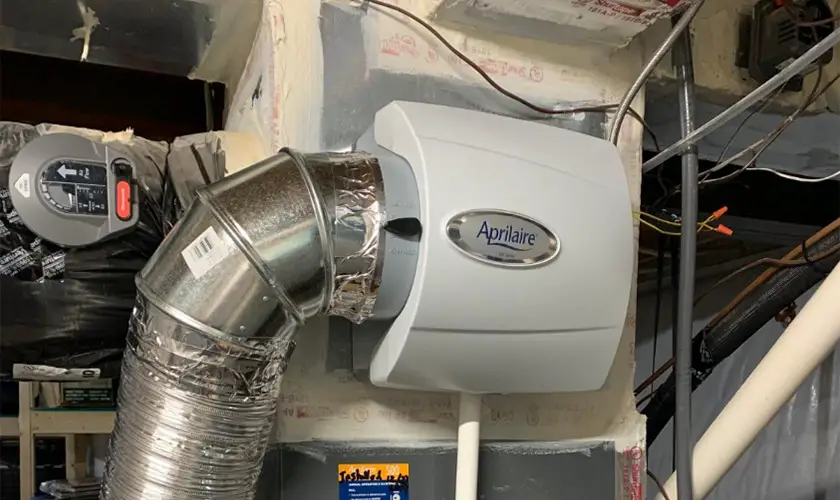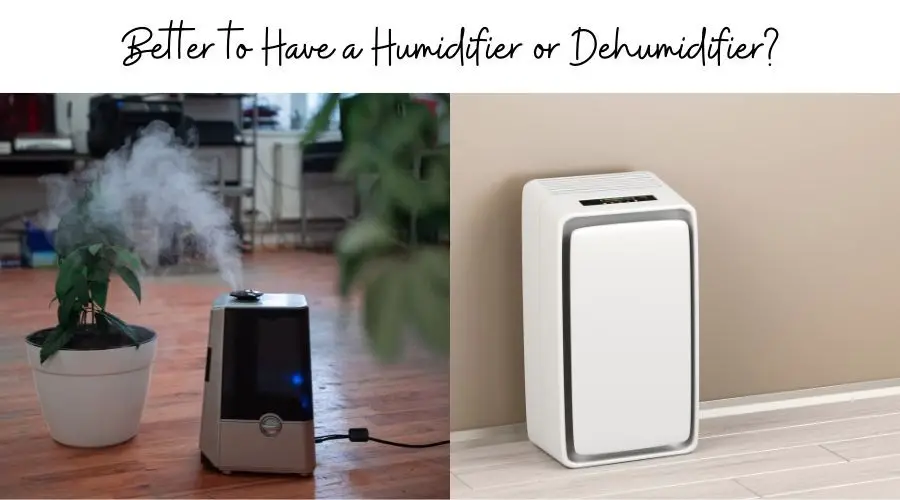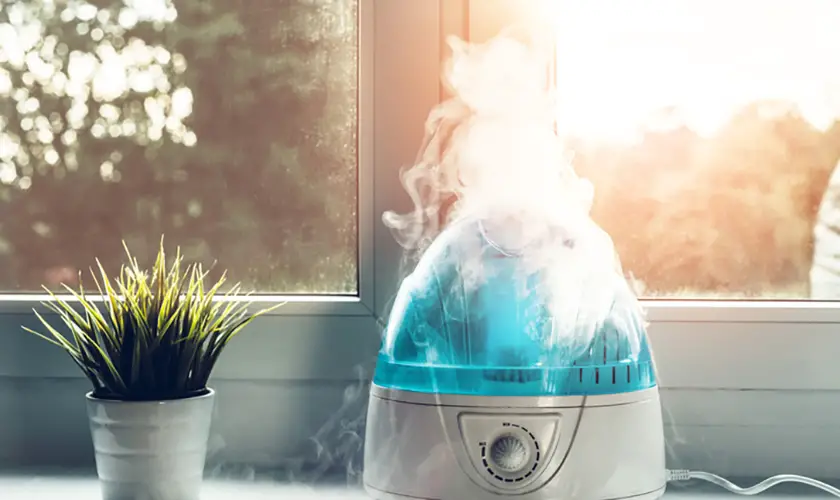
Vaporizer vs humidifiers performs essentially the same task. They both add moisture to dry air, but they do it differently.
Dry air can cause several problems, including allergies, dry skin, sore throat, and stuffy nose. It can also affect our immune systems by making it harder for our nasal passages and lungs to trap germs.
Vaporizers and humidifiers help address these issues by adding moisture to the air. But how do you know which one is right for you? Read on to discover the key differences between vaporizers and humidifiers to make an informed decision.
Vaporizer vs Humidifier Key Takeaway
A humidifier might be the right choice if you experience dry sinuses, static electricity shocks, or discomfort in your home.
Ensure you get great results by following these guidelines: take allergies people in your household have into account, prioritize safety measures (especially if you have small children), and determine how much space needs to be humidified.
Vaporizer vs Humidifier: How They Work
The critical difference is that humidifiers use cold or warm mist, while vaporizers boil water and release steam. In addition to making you feel more comfortable, these machines can relieve irritated noses, throats, chapped lips, and dry skin. Just be sure not to over-humidify and keep the machine clean!
Vaporizer
Vaporizers, a kind of humidifier, also add moisture to the air. They do this by creating steam. Inside a vaporizer, water is boiled until it makes hot vapors that go into a room. People can also add inhalants to vaporizers but not to regular humidifiers.
A vaporizer is a warm mist humidifier that uses boiling water to create hot steam. Both appliances can ease discomfort when used properly, but daily cleaning is essential to decrease the risk of bacterial growth. Because they use boiling water, vaporizers may not be appropriate around small children.
- A vaporizer boils water and releases it into the air as steam
- It contains fewer contaminants than other methods
- It may be hot enough to burn skin
- Mineral deposits may create bacteria buildup
Humidifier
A cool-mist humidifier adds moisture to the air to combat dry climates or relieve cold and flu symptoms.
Humidifiers are appliances that help the air feel less dry. They do this by releasing cool vapors into the room. These vapors are made by a disk that turns quickly and is submerged in water. Humidifiers can be beneficial in usually dry places, and people might have difficulty breathing because of how the air feels.
- A humidifier diffuses the water into a cool mist to add humidity to the air.
- It has an option of warming mist before releasing it into the air.
- The cool or warm mist will not cause burns.
- Less likely to have mineral impurities.
Neither humidifiers nor vaporizers purify the air. Only an air purifier can remove impurities from the air. For the best air purifiers, see:
- Best Air Purifier for Smoke (Wildfire, Tobacco, Cigar, & Weed)
- Best Air Purifier for Mold, Viruses, and Bacteria
- Best Air Purifier for Large Rooms
- Best Air Purifier for Pet Owners
Vaporizer vs Humidifier: Varieties
There are several types of humidifiers. A central humidifier can be hooked to a house’s heating equipment to receive water and humidify an entire home. In contrast, a tabletop or room humidifier is smaller and must be filled manually.
There are also evaporative humidifiers, which capture all minerals and pollutants, and ultrasonic humidifiers, which create vapors using sound waves and are usually very quiet.
Cool mist humidifiers, which use a spinning disk, are cheaper and more common than other humidifiers.
Vaporizers are warm mist humidifiers, but there are various versions of these as well. Varieties of vaporizers include portable vaporizers (which can be handheld) and electric vaporizers that plug into a wall.
Vaporizers are also classified by the way they heat liquid: either by way of thermal conduction, convection, or thermal radiation.
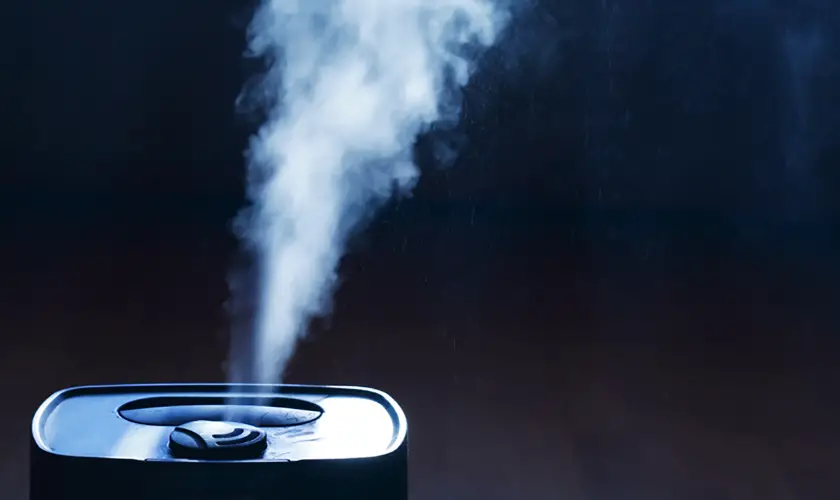
Vaporizer vs Humidifier: Usage
A humidifier is a device that adds moisture to the air in a room. It uses a fan to blow heated water through a chamber containing activated charcoal. The heat evaporates the water, leaving only moistened air behind.
A vaporizer works similarly to a humidifier, except it blows steam directly into the air instead of blowing hot water through a chamber. The steam condenses on surfaces inside the room, creating a foggy atmosphere.
Both types of appliances are great at combating dry air, preventing the buildup of static electricity, relieving discomfort associated with dry skin and nose, and helping to prevent babies and young children from developing respiratory issues due to dry air.
However, vaporizers tend to be better than humidifiers regarding safety. They don’t require cleaning, and they don’t produce any harmful vapors.
On the other hand, humidifiers do require regular cleaning and should never be placed near a stove or oven.
You’ll notice that most vaporizers come with a built-in heater. If you plan on using a humidifier around a baby or toddler, place it away from the crib or playpen.
Following proper safety precautions if you use a vaporizer to treat your respiratory ailments. Never inhale the vapors produced by a vaporizer, and avoid placing it too close to flammable materials. Also, store the device out of reach of curious children.
Vaporizer vs Humidifier: How They Help
Humidifiers, vaporizers, and humidifiers can help improve the indoor air quality of your home by adding moisture to the air. This increased moisture in the air can benefit those who suffer from allergies or other respiratory conditions by alleviating symptoms such as sore throats, congestion, and dry skin.
Watch Out for Too Much Moisture
Avoid overdoing it with moisture if you use a humidifier or vaporizer. If a room’s humidity level becomes too high, it will create an environment in which mold and bacteria can thrive. 30% humidity or lower is ideal; anything above 60% risks mildew growth.
You can measure humidity levels with devices like hygrometers, or some humidifiers/vaporizers have pre-set settings.
Allergies
If you suffer from indoor allergies, a humidifier may help to ease your symptoms. Relative humidity should be below 30% for best results, but be careful not to overdo it – high humidity can increase dust mites, mold, and other allergens.
A vaporizer uses heat to release water molecules from the liquid form into the gas phase. This process creates a mist inhaled through the device’s mouthpiece. Because vaporizers do not emit large amounts of dust particles, they are recommended for those with respiratory issues. However, vaporizers are less effective at removing airborne pollutants compared to humidifiers.
If you use a humidifier, clean it thoroughly every day with distilled water to help control allergies. Always consult with your healthcare provider before changing symptom mitigation methods.
The American Academy of Allergy, Asthma, & Immunology (AAAAI) suggests that dust and mold from the humidifier may cause more harm than good if you have indoor allergies.
While humidifiers reduce the presence of allergens, they are ineffective at eliminating them. As a result, they are not recommended for those with severe allergies.
To find out which product is right, consult your doctor or allergist. They will be able to recommend the best option for your needs.
Asthma
If you have asthma, using a humidifier or vaporizer may not be the best. But if dry air makes you uncomfortable and you still want to use one of these devices, be extra careful about cleaning it often so that nothing in the air will cause your symptoms to worsen.
Keep an eye on the humidity level, though–you don’t want it to get too high because this promotes mold and bacterial growth, which can trigger asthma attacks.
Babies
Because babies have delicate skin and nasal/throat passages, adding humidity to a dry room can be comforting.
A humidifier is the safer choice for a baby’s room, so there is zero chance of the baby being scalded by steam from a vaporizer. Always clean the device daily and thoroughly, then check the humidity level often.
According to Mayo Clinic, Julie Baughn, M.D., warm-mist and cool-mist humidifiers are equally effective in humidifying the air. When the water vapor reaches your child’s lower airways, it’s the same temperature regardless of whether it started warm or cool.
Colds, Congestion, and Flu
Both cool mist humidifiers and steam vaporizers can help combat congestion caused by colds or the flu. However, there are pros and cons associated with using either device.
For instance, steam vaporizers produce more moisture than cool mist humidifiers. As a result, they may not be ideal if you suffer from allergies or asthma. On the other hand, cool mist humidifiers tend to produce less moisture than steam vaporizers, making them a great option if you have respiratory issues.
Whether you prefer cool mist humidifiers or steam vaporizers, both devices can help alleviate symptoms caused by colds and flu.
COVID
The coronavirus survives better in dry air, so increasing the moisture levels could theoretically decrease the number of viral particles present. In general, viruses don’t do as well in humid environments.
Although they may offer some help, humidifiers and vaporizers should not be relied on entirely to rid your home of potential exposure to COVID.
Remember to follow all safety guidelines still. Air purifiers might remove coronavirus particles from the air, but most home systems do not have sophisticated enough filters to eliminate them.
Dry Skin
A vaporizer or humidifier can help alleviate discomfort from chapped lips or dry skin. Keep the device clean and ensure the air isn’t too humid. If you need more moisture, drink plenty of water throughout the day to stay hydrated. Additionally, apply moisturizing products to your skin as required. Choose products that are appropriate for your particular skin type.
How to Clean a Vaporizer vs Humidifier
A vaporizer or humidifier is a great way to enjoy fresh air without getting sick. However, if you don’t properly maintain it, it can cause health problems. One of the most common maintenance issues is cleaning. Follow these simple tips to keep your vaporizer or humidifier running smoothly.
- You should wash your water tank regularly with water and white vinegar. Be careful not to immerse the electrical components in the water. After washing, let it dry completely and store it in a cool place away from direct sunlight.
- Use a soft toothbrush or rag to clean off the inside of the device. Don’t submerge the electrical components in the liquid. Instead, gently brush or wipe them off.
- To clean the outside of the device, use a diluted bleach solution or hydrogen peroxide. Again, be careful not to immerse the electrical components in either chemical.
- Follow the manufacturer’s instructions to disinfect the device. These chemicals may harm the plastic or seals, causing the unit to leak or malfunction.
How Does the Cleaning Process Differ?
There are many differences between the cleaning processes for cool-mist humidifiers and steam vaporizers. Cool-mist humidifiers require daily cleaning because minerals and bacteria build up quickly. Steam vaporizers do not require daily cleaning because boiling removes most contaminants. However, steam vaporizers still require weekly cleaning to prevent mineral buildup.
Both need to be kept free of mineral buildup. Mineral buildup can cause adverse health effects, including respiratory issues.
To avoid mineral buildup, you must empty the tank and dry all surface areas of the unit. Then, refill the unit with fresh, distilled water and let it sit overnight. Afterward, scrub all surfaces with mild dish soap and warm water to remove mineral buildup. Finally, rinse thoroughly with clean water.
If you notice mineral buildup after refilling, you may need to change the filter. Follow the manufacturer’s directions for changing the filter.
You should also regularly clean steam vaporizers by emptying the tank and letting it soak in a mixture of white vinegar and water for at least 20 minutes. Once the tank is drained, wipe down all surfaces with a soft cloth and mild detergent. Rinse well with clear water.
Finally, store your unit properly. Please keep it in a cool, dry location and follow the manufacturer’s instructions for storing the unit.
Vaporizer vs Humidifier: Cost
While humidifiers typically cost more than vaporizers, this isn’t always true. Additionally, you may have to buy replacement filters or wicks for your humidifier down the line.
There’s a huge difference between vaporizers and humidifiers. A vaporizer is used to heat water to produce steam, creating air moisture. A humidifier adds moisture to the air. There’s a wide range in cost, ranging from about $15 to $700 for a room humidity machine.
You’ll find that most vaporizers are less expensive than humidifiers. However, you might spend more on a humidifier if you want certain features, such as remote controls, sleep modes, timers, etc.
Measure the room you want to add moisture to and determine the machine’s capacity you plan to purchase. Determine whether you need a humidifier with additional features like remote control, sleep mode, timer, etc.
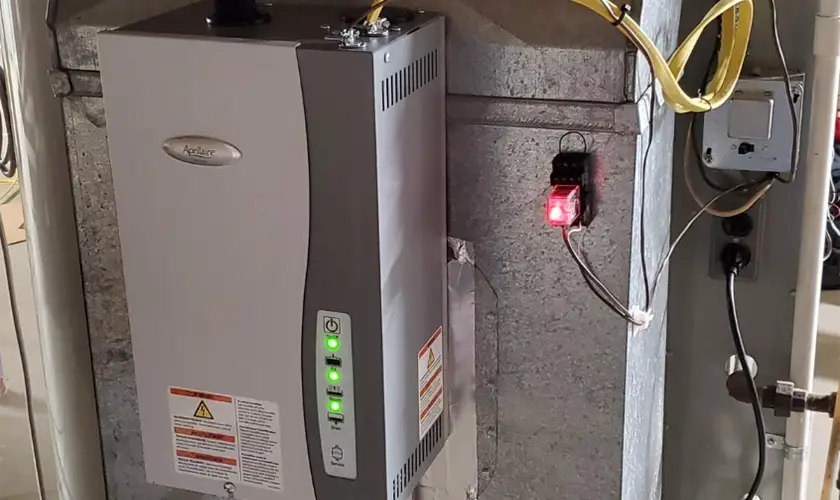
Vaporizer vs Humidity: Safety & Risks
The cleanliness of your humidifier or vaporizer should be one of your top priorities. Not keeping it clean could result in dangerous airborne particles, including pathogens and allergens. We recommend not using a vaporizer if you have a baby or child, as the steam could burn them. Always remember to unplug the device before beginning to clean it.
A vaporizer is safer than a humidifier because it doesn’t emit any harmful chemicals. However, if your child accidentally knocks over a vaporizer, there’s a chance that it could spill hot water onto themselves. On the other hand, a humidifier emits mineral-rich steam, which can burn skin and eyes.
To keep your child safe, clean your vaporizer daily and avoid using it near children. Also, never leave a humidifier unattended. You’ll want to ensure that no one else uses it.
Both vaporizers and humidifiers can be dangerous if left unattended, so make sure that you clean them regularly. Cleaning is simple, and most models come with cleaning instructions. Just wipe the device with soap and warm water and let it air dry.
You may also want to consider getting a humidifier that automatically turns itself off after 15 minutes of nonuse. This prevents overheating and helps prevent mold and bacterial growth.
Vaporizer vs Humidity FAQs
How Long Can You Keep a Vaporizer On?
You can keep a vaporizer on for as long as you like, but monitoring the air’s moisture level is important. The humidity level can create an ideal mold and mildew growth environment if the humidity level gets too high. Most small portable vaporizers will shut off automatically when the reservoir is empty.
In larger portable and whole-house vaporizers, set a timer or use a humidistat that automatically turns the unit off when the desired humidity level is reached.
Which is Better: Cool Mist or Warm Mist Humidifier?
Warm mist humidifiers can help to loosen congestion and make breathing easier. Cool mist humidifiers do not emit heat, making them a safer option for households with children or pets. Ultimately, deciding which humidifier to use depends on your preferences and needs.



